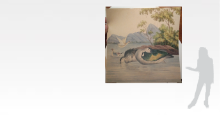
ATTRIBUTABLE TO CHRISTOPHER WEBB SMITH, PATNA, CIRCA 1830
Watercolour on paper
Image: 6.5 x 8.25 in (16.7 x 20.7 cm)
NON-EXPORTABLE REGISTERED ANTIQUITY
PROVENANCE
The artist's family
Thence by descent
Christopher Webb Smith was born in 1793 in Camberwell, London. Smith is famed for his magnificent watercolours of African and Indian birds, a talent that stemmed from his keen interest in ornithology. Smith joined the British East India Company in 1808. Along with Sir Charles D'Oyly, another public official and artist of renown, Smith set up the first British lithographic printing press in Bihar. D'Oyly and Smith published a two-volume work on birds: The Feathered Game of Hindostan in 1828, and Oriental Ornithology in 1829, which included plates documenting birds and their habitat. Smith passed away in Florence, Italy, in 1871.
Company School Painting
The Company School of painting refers to paintings made in British India in the late 1700s and early 1800s. With the British East India Company expanding its reign over the South Asian subcontinent, a large number of its employees from England were posted in India. As they travelled extensively across India, they were taken in by its flora and fauna, ancient monuments, local people and their lifestyles. Some employees hired local artists to undertake precise documentation, and trained them in the European norms of perspective, scale and proportion, and shading, including a muted colour palette. The artists combined these new techniques with the ornamentation and detailing of Mughal painting traditions to give rise to a hybrid style. Company School paintings are identifiable by their muted watercolour tones and perspective construction that is markedly different from miniature paintings. Employees of the British East India Company often sent these paintings of their new environment back to family and friends in England.
Company School painting developed in cities which were major political and economic centres for the British with, Calcutta and Patna being the most significant. English art historian Mildred Archer notes that by 1800, Patna was an important administrative headquarters which was home to European judges, barristers, lawyers, chaplains, merchants and doctors, as well as wealthy Indian landowners. Eminent artists such as Bani Lal, Hulas Lal, and Shiva Lal received patronage from the city's wealthy residents and further enhanced its reputation as a centre for artistic development. Their paintings document animals, locals and their attire, as well as quotidian scenes such as people gathered at a railway station or women on their way to temples. Facial features and contouring show a great degree of finesse, while perspective and shading are in the European style. Works by these three artists are among the Company School paintings in this catalogue.
Other similar works in:
this auction
|
entire site

Lot
24
of
87

CLASSICAL INDIAN ART
10-11 APRIL 2018
Estimate
Rs 1,50,000 - 2,00,000
$2,345 - 3,125
RESERVE NOT MET

Size Size

Height of Figure: 6'